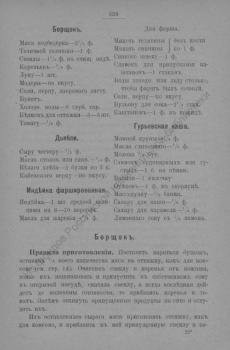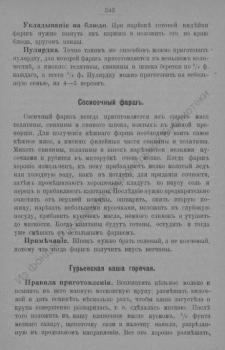Petersburg Cuisine
Dish Recipes
Borscht
Leg meat — 2 ½ Russian pound
Veal shank — 1 Russian pond
Peeled beetroots — 1 ½ Russian pound
Root vegetables — 5/8 Russian pound
Onion — 1 pc.
Madeira — to taste
Salt, pepper, bay leaf
Bunch of greens
Cold water — 8-10 deep bowls
Egg whites for clarifying the broth — 3-5 pcs.
Tomatoes — 1/3 Russian pound
Cooking rules
Put the broth to boil, leaving ⅛ of the total amount of meat to clarify the broth, peel the beets and root vegetables from the skin, chop them finely and stew the beets in their own juice, when they reaches half the readiness, add the root vegetables and tomatoes. Then drain the fried foods with a sieve and cool them.
From the left raw meat and bones of the chicken, cook a clarification and add the sautéed beets and roots to it. Having warmed all this with a small amount of broth, pour the clarification into a saucepan with broth, quickly stir the latter, then put it on a slow fire without closing the saucepan with a lid.
After 1 hour or 1¼, when the borscht is completely clean and has a good taste, add a beet dye (mix the grated beets with a little broth and boil) and strain it through a wet napkin. After straining, boil on the stove. Before serving, add cayenne pepper to taste.
Explanations and notes
Clarification. Borscht is cooked with clarification, as it belongs to the number of strong, clear soups. A clarification can be made from chicken bones only (without beef), in which case it acquires a more delicate taste.
Beets. In order for the borscht to get a strong taste of beets, the latter should be put in the clarification and added to the broth along with it. Only simmered beets are placed in the clarification, otherwise the borscht will get a raw taste, and do not put hot beets in the clarification, this will make meat immediately coagulate and does not give the clarification the desired strength. Also, beets with a large amount of oil, which is added to the beets when stewing, should not be put into the guy, then the borscht will not be transparent; in view of this, it is necessary that the beets, before lowering into the guy, be thrown back on a sieve through which oil or fat will drain from it. Also, do not put in the clarification beets with a lot of oil which is added to the beets when stewing, otherwise the borscht will not be clear; in view of this, it is necessary that the beets, before adding to the clarification, be drained through ia sieve to remove the oil or fat. The clarified borscht should be cooked for at least an hour so that the clarification and beets are completely boiled out and give their taste to the soup. Beetroot must be cooked in an open container, otherwise it will lose color.
Tomatoes are added to the borscht in small quantities to give a light acidity.
Red color. Since borscht becomes not red, but yellowish during long cooking with beets, it is necessary to give it a dark red color with beetroot broth without vinegar, because the latter makes borscht cloudy.
A note about the clarification. Since the method of cooking borscht is no different from cooking consommé from vegetables, you must follow all the rules that are applied in the preparation of consommé.
Hot Guryev Porridge
Semolina — 100 g
Butter — 50 g
Milk — 3/4 bottles
Cream ordinary or thick — 1 bottle for foams
Vanilla — 1 stick
Nuts — 400 g in shell
Macedonia — ½ jar
Sugar for porridge — 50 g
Sugar for caramel — 100 g
Lemon juice — from ½ lemon
Cooking rules
Boil whole milk and pour Moscow semolina into it, stir with a spatula and let it boil several times so that the porridge thickens and the cereal is completely boiled, that is, it becomes soft. After that, put in the porridge butter breaking it into pieces, 50 gr. fine sugar, a pinch of salt, a vanilla stick cut lengthwise, mix it all well, cover the pan tightly with a lid and put to steam (in a pan with hot water) in a medium temperature oven for half an hour.
While the porridge is kept in the oven, prepare the foams as follows: pour thin cream into a spacious shallow saucepan, put them in the oven at medium heat or, even better, if possible, in a Russian stove. As soon as a ruddy foam forms on the surface of the cream, carefully remove it with a fork or slotted spoon on a plate, and put the cream back in the oven until a new foam appears, and do so until all the cream has turned into foam and from them at the bottom of the saucepan only a thick sediment will remain, which put into the porridge and remove the vanilla from it.
When everything is ready, take a metal form, in which the porridge can be served to the table, grease a little butter inside, spread a layer of porridge on the bottom, add the next layer of foams on top, then a layer of caramelized walnuts or roasted nuts, broken into pieces, and fruits. massedouan, cut into beautiful slices, then again a layer of porridge and so on — to the top of the form. The topmost layer should be of porridge. Having laid everything in the indicated order, sprinkle fine sugar on top and gild it with a red-hot salamander (a metal board for tinting) or, in the absence of the latter, with the end of a clean, red-hot poker or an iron, so that sugar gives a golden crust.Having tinted the porridge, decorate the top more beautifully with some patern (in the shape of stars or garlands) from the remaining massedouan and whole halves of caramelized nuts, and serve hot. Porridge is served with hot apricot puree or fruit juicein a gravy boat .
Explanations and notes
Serving Guryev porridge. Guryev porridge is made in two ways, namely: hot and cold. The latter is served instead of ice cream.
Milk. The milk used for porridge can be replaced with thin cream, which will make the porridge even tastier.
The proportion of milk for porridge must be exact, i.e. measure no more than 3/4 bottle per ¼ Russian pound ofcereals; otherwise, the porridge will be liquid.
Cooking porridge. The groats are always poured into boiling, not cold milk, which sticks the groats together, resulting in a tasteless, sticky porridge. While the porridge is cooking on the stove, it must be stirred with a spatula so that it does not burn to the bottom, which will give it an unpleasant bitter taste.
Sugar. Sugar is added to porridge at a time when it is already ready, i.e., the groats become tender, and not during cooking, when the groats are still raw. This rule must be observed because sugar not only slows down, but even completely stops cooking; therefore, if it is put at a time when the cereal is still raw, the porridge will not be cooked enough and will have a raw taste. You should not put a lot of sugar in porridge, because from caramelized nuts and massedoine it already gets a rather sweet taste.
Vanilla. Vanilla is cut lengthwise to give more flavor.
Oven. After the porridge is filled with butter and sugar, it is placed in the oven so that the butter and sugar are well absorbed into the cereal. Porridge is placed in the oven to "steam" in order not to burn to the bottom of the pan.
Foams. To get good, fatty foams, it is best to use thick cream, but since this significantly increases the cost of the dish, they can be replaced with thin ones, and in order to get fatter foams, you need to add a piece of butter (with a walnut) to thin cream. For the convenience of removing foams and to get a large amount of them, you need to use a wide saucepan for the cream. The foams should only be colored with a ruddy, reddish, but by no means brown hue, because burnt foams give the porridge a bitter taste, just like burnt caramelized nuts.
Nut caramelization. See walnut ice cream (lunch № 27).
Caramel crust. To get a golden crust of sugar, you need to gild the sugar in the indicated way, and not put the porridge in the oven,in which it only becomes liquid, since the sugar will not fry, but simply dissolve.
Note. Guryev porridge is sometimes added with ground, as for a cake, non-caramelized nuts, which are directly mixed with porridge, which makes it gray; but in this case, the porridge is not as tasty as with caramelized nuts.
Frozen Guryev Porridge
Cooking rules
Cook semolina, foams and caramelized nuts. After removing the porridge from the oven, add to it the foams cut into small pieces, and caramelized walnuts which are first broken into small pieces, and mix everything well. After the nuts, put the candied fruit (1/4 Russian pound = 100g), chopped into small cubes and sprinkled with rum, into the porridge, stir and put 1 cup of heavy whipped cream. Mix well the porridge with cream, put it in a thick Charlotte Mold (copper) or in an ice cream maker, close the mold tightly with a lid, grease it with butter and cover it over with ice and salt, like parfait; keep on ice for at least two hours. After this time, remove the mold from the ice, rinse thoroughly with cold water and remove to a platter like ice cream.
All explanations and notes about the hot Guryev porridge apply in this case.
Thick cream. Thick whipped cream should be added to cold, not hot porridge, since the cream will fall off from the hot temperature, that is, it will curdle, and will only dilute the porridge, and will not give it tenderness.



